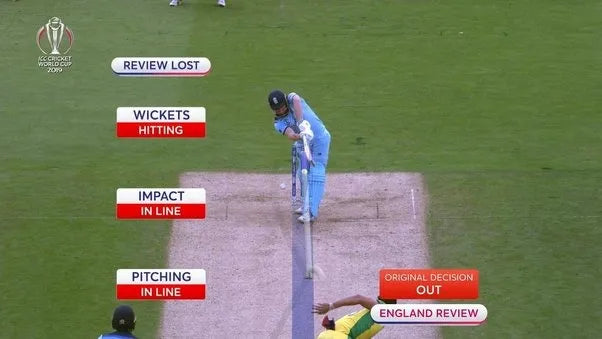There are multiple ways a batter can be dismissed out in a game of cricket. The batter can be clean bowled, run out, caught out, stumped out of the 12 types of getting a batsman out in cricket. But of all these ways, one method is the most confusing for first time cricket watchers and that’s the LBW method. The dynamics involved in it, the ball pitching, the impact of the ball, all of these make it super difficult for people to understand this method of dismissal.

So, in this article by ZAP, let’s explore the meaning of LBW in cricket, it’s full form, the history and how it was first used and the rules and regulations regarding this method of dismissing the batsman.
What is LBW and its full form in Cricket?

The full form of LBW is Leg Before Wicket, which is one of the most common ways a batsman can be dismissed in cricket. If a ball bowled by the bowler hits any part of the batsman's body (except the hand holding the bat) and would have gone on to hit the stumps, the fielding team can appeal to the umpire, shouting "Howzat!" The umpire then decides whether the batsman is out based on where the ball pitched, whether it would have hit the stumps, the ball's path after hitting the batsman, and whether the batsman was trying to hit the ball.
The history and origin of LBW in cricket:
![A 1904 illustration from the Badminton Library's Cricket, showing a batsman who is leg before wicket. The original caption was "A clear case" [of lbw].](https://cdn.shopify.com/s/files/1/0278/4565/6649/files/WhatsApp_Image_2024-05-04_at_05.08.01.webp?v=1714779671)
The LBW (Leg Before Wicket) rule in cricket has an interesting history.
1744: The Early Days
In 1744, when the Laws of Cricket were first written down, there was no LBW rule. Batters used curved bats and the batting technique then was very different from what it is now, so it was rare for batters to stand directly in front of the wickets. However, as bats became straighter and cricket batting techniques got more refined, batters began to stand straight while covering the stumps and obstructing the ball from hitting the wickets on purpose with their legs or batting pads.
Also Read: Cricket Batting Stance
1774: The First LBW Rule
In 1774, the first leg before wicket rule was introduced, which stated that a batter would be given out if they deliberately stopped the ball from hitting the stumps with their leg. This rule was a very primitive attempt at penalising batsman for this foul play and many more revisions were yet to come.
1823: Clarification and Ambiguity
In 1823, it was clarified that the ball must be delivered in a straight line to the wicket. However, there was still confusion about the interpretation of the rule, leading to disagreements among umpires. During the late 19th and early 20th century, the rule faced controversy and there were attempts made to reform the rules. Batters began using their batting pads to prevent the ball from hitting the wicket, leading to debates about fair play and the balance between batters and bowlers.
1937: Official Inclusion of LBW into the Laws of Cricket
Several proposals were made to prevent this "pad-play," but none were successful initially. It wasn't until 1935 that a significant change was made to the leg before wicket rule. An experimental law was introduced, allowing a batter to be dismissed LBW even if the ball pitched outside the line of off stump. This change aimed to make the game more exciting and balanced between batters and bowlers. Despite initial opposition, the experiment was deemed a success, and in 1937, the new rule became part of the official Laws of Cricket.
The Laws and Rules of LBW (Leg Before Wicket):

The following are the LBW (Leg Before Wicket) rules that decide whether a batsman can be dismissed in this manner or not.
- The Basics:
- A batsman can be out Leg Before Wicket if they obstruct a ball with any part of their body (except their hands) that was on its way to hit the stumps.
- Hands, up to the wrists, are considered an extension of the bat.
- Conditions for LBW:
- The ball must be a legitimate delivery, not a no ball.
- The first point of contact is crucial. If the ball hits the bat or hands first and then the player’s body, it cannot be given as Leg Before Wicket.
- The ball must pitch in line with the three stumps or to the off side of the batsman's off stump.
- If the ball pitches outside the line of the batsman's leg stump and then swings or spins towards the wickets, it cannot be given as LBW.
- Subtleties:
- If the ball pitches outside the off stump line and turns towards the wickets, the batsman can be given out if the point of impact between the ball and the batsman's body is in line with the stumps.
- However, if the point of impact is outside the off stump line, the batsman can only be given out if they were not offering a shot.
- Whether a batsman has genuinely attempted to play the ball becomes the trickiest part of Leg Before Wicket decisions.
Use of Technology and Decision Review System in Leg Before Wicket (LBW):

Leg Before Wicket is one of the most controversial aspects of cricket because if directly involves a subjective judgement by the umpires, which can influence not only a match, but an entire tournament for a team. There’s a lot of room for the umpire’s bias or incompetence to influence a wicket in their LBW decisions.
But with the development of technology and ball tracking system’s like Hawk Eye, broadcasters were able to show viewers precisely where the ball pitched, its trajectory, and whether it would have gone on to hit the stumps or not. This increased transparency and accuracy in Leg Before Wicket decisions started influencing the umpires as well. After initial hiccups, the Umpire Decision Review System (DRS) was officially introduced in 2009, allowing teams to challenge on-field LBW decisions.
The DRS has had a significant impact on the game. According to the ICC's Dave Richardson, umpires have become more confident in giving Leg Before Wicket decisions, especially against batters standing further away from the stumps, as they could visualize the ball's path better since they knew that any obvious errors could be corrected through the review system.
But there were still some people who challenged the reliability of the DRS for Leg Before Wicket dismissal decision. One of the major opponents of DRS was the Board of Control for Cricket in India (BCCI), which initially refused to use it due to concerns over the reliability of ball-tracking technology. However, after years of resistance, the BCCI finally accepted DRS in 2016.
Also Read: How to become a cricket umpire
FAQ:
What is the difference between leg bye and LBW?
- Leg bye: A run scored when the ball hits the batsman's body, not the bat or gloves, and then the batsmen run.
- LBW (Leg Before Wicket): A dismissal where the ball hits the batsman's leg before hitting the bat and, in the umpire's opinion, would have gone on to hit the stumps.
Can umpire give LBW without appeal?
Yes, the umpire can give LBW without an appeal if they believe the batsman is out according to the laws of cricket.
Now that you have read about LBW meaning and rules in cricket, here are some more articles we recommend you read:
Powerplay rules | DLS Method in cricket | Cricket Fielding Positions



Share:
Types of Outs in Cricket | How to Dismiss a Batsman in Cricket
Longest Sixes in IPL History: The Strongest Batsmen | IPL Records